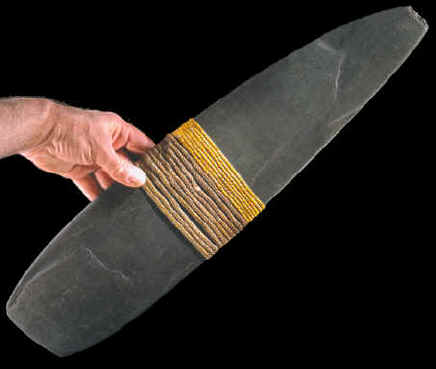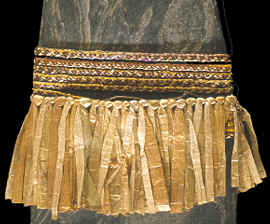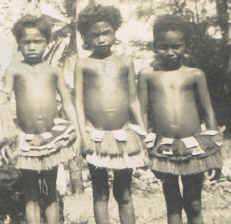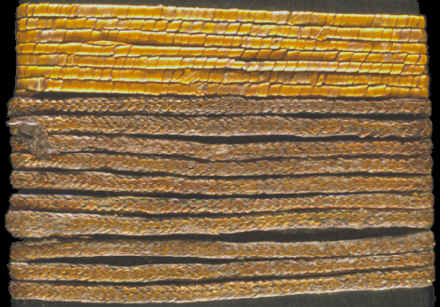|
Stone wealth display-exchange stones are used in funeral
displays & distribution, marriage wealth transfer, war indemnity payments,
as a stone of value for trading purposes and a source from which to select
sacred symbolic stones (1999:
Hampton p. 114).
Hampton measured 38 profane display exchange stones. Their measurements were 7 11/16
inches (19.5 cm) to 35 1/4 inches (89.5 cm) long and 2 3/8 inches (6 cm) to 5
1/2 inches (14cm) wide and 5/16 (.9 cm) to 13/16 inch (2 cm) thick. The
average length was 22 1/4 inches (56.4 cm) long, 3 3/4 inches (9.6 cm)
wide and 5/8 inch (1.5 cm) thick (1999:
Hampton p. 105).
|
|

CLICK ON
PICTURE FOR LARGE TRIPLE IMAGE
DECORATED DISPLAY-EXCHANGE
STONE
DANI
CULTURE
IRIAN JAYA, INDONESIA
PETE BOSTROM COLLECTION
This display-exchange stone was collected sometime in the 1950's. It
was originally in a collection in Java. This one is decorated with two wrappings of
orchid fiber cording. These miniature skirts are representative of a
miniature wrap
around wedding skirt (jogal). Although the picture doesn't show it,
the color of the stone is actually dark green and black. The surface
has been well smoothed on both sides and the edges. This display exchange stone measures 21 3/8 inches (54.3 cm) long, 5 inches (12.7
cm) wide and 1/2 inch (1.2 cm) thick. This display-exchange stone
might have been worth one medium sized pig (1999: Hampton, pp.
113-114). |
|
|
There are several different names for display-exchange
stones. Some of the different names are je, jao, sie and siengga. Also, if an
individual so desires he can select a display-exchange stone to be converted
into a sacred object for use as an ancestral spirit object or as a tool with
supernatural powers. Then, a stone might then be called " Gutelu's
stone." A
quote from Daoke Mabel, a Dani tribesman helps explain, "Gutelu's spirit
is in this stone, and the stone is placed so that Gutelu will always be with
us in the ganekhe house (place where sacred objects are stored),"
(1999:
Hampton, p.150). "Gutelu's
stone" was the largest stone measured by Hampton. It measured
almost 4 feet (121 cm) long (1999:
Hampton p. 105).
|
|


SKIRT DECORATION ON DISPLAY-EXCHANGE STONE
AND 3 CHILDREN WEARING BANANA LEAF SKIRTS
IRIAN JAYA, INDONESIA & KIRIWINA PAPUA NEW GUINEA
PETE BOSTROM COLLECTION
The picture at left shows the two typical examples of "skirt"
designs that are used to decorate display-exchange stones. This
stone has been wrapped with two different kinds of skirts. One is
the wrap around wedding skirt called a jogal that is made of orchid
fiber cording. The other is a drop skirt called a sali that is
usually worn by young girls and is made of flattened reeds. There is
also another wrap around skirt on this stone that is hidden, out of
view, under the drop skirt and it is made of bright yellow orchid
fiber.
The picture on the right is taken from a Papua
New Guinea Missionary's photo album dating to the late 1940's. The
location is on the island of Kiriwina in Papua New Guinea. The three
young children are wearing their "Sunday best" skirts made
from banana leaves. These female short skirt motif designs seem to
be a common theme of decoration on display-exchange stones. |
|
|
Display-exchange stones are laid out in rows during
funerals. They are brought in separate funeral bundles that contain
strapless ceremonial nets, cowrie shell bands and usually anywhere from three
to seven display-exchange stones. Each bundle is laid out very carefully with
either grass or banana leaves on the bottom. Then carefully folded nets are
laid down with the exchange stones laid on top. On top of the exchange stones are placed
the cowrey shell bands.
|
|

TWO WRAP AROUND
SKIRT DECORATIONS
ON DISPLAY-EXCHANGE STONE
DANI
CULTURE
IRIAN JAYA, INDONESIA
PETE BOSTROM COLLECTION
This picture shows a typical example of a "skirt" wrapping
used to decorated display-exchange stones. This stone has been
wrapped with two different "skirts." This is a female
motif design that represents a wrap around wedding skirt called a
jogal. It is made of orchid fiber cording. |
|
|
It has been recorded that in some funerals that involved a
"big man," as many as 400 display-exchange stones were laid out. The
number of funeral bundles would depend on the importance of the individual
that had died. A funeral may have as few as one or none to more than 400
stones.
|
|
CONTINUE ON TO PAGE
FOUR
|
|
"REFERENCES"
1968,
Gardner, Robert & Heider, Karl G., "Gardens of War, Life and
Death in the New Guinea Stone Age," p. 87.
1970, Heider, Karl G., "The Dugum Dani," p. 288.
1978, Marcus, Rebecca B., "Survivors of The Stone Age," p.
113.
1998, Konder, Albert, Personal Communication, Letter.
1999, Hampton, O. W., "Culture of Stone, Sacred and Profane Uses
of Stone Among the Dani,"
|
|
HOME
ORDERING |




